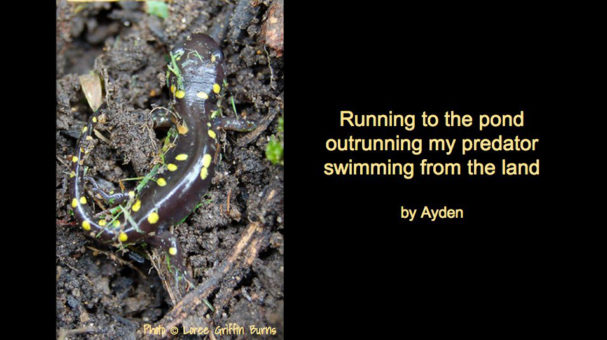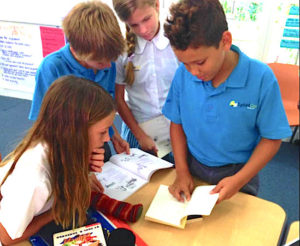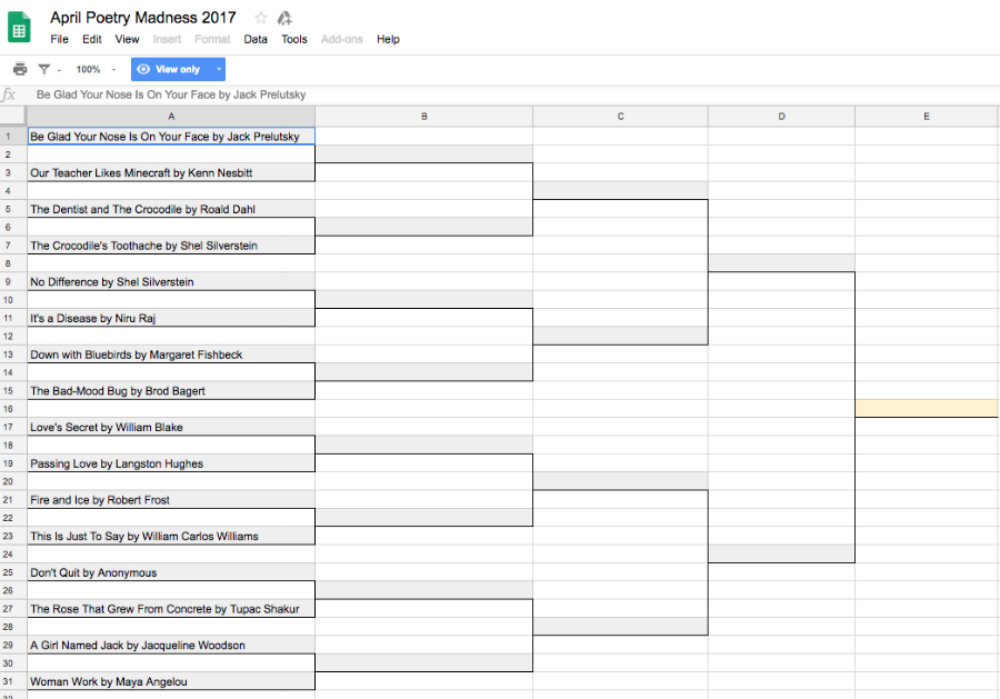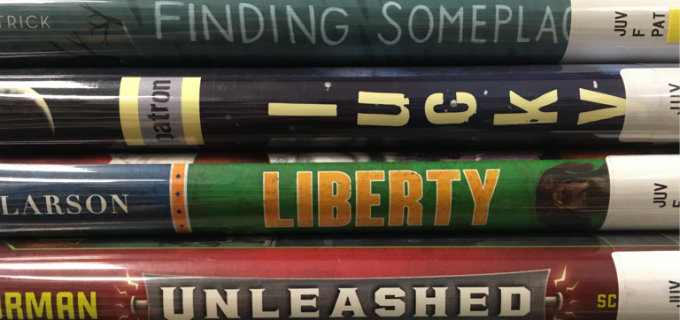Ideas to Integrate Poetry Throughout the Year
A MiddleWeb Blog

I’m creating this list to hold myself accountable and help out others who are in the same situation. These short activities can be used a variety of ways and in various subject areas to keep poetry closer to the surface of student awareness.
Host a poetry bracket competition.
The favorite poetry activity of my students (and myself) is the Poetry Madness bracket competition. Inspired by March Madness, two poems are read each day and students vote on which one they prefer. The winner moves forward in the competition to face the winner of another day, until we finally have the ultimate poem for the year.
There are many ways to do this, but I like to do it in March as we lead up to our poetry unit. We don’t analyze or pick the poems apart; we just enjoy them and root for our favorites. I try to pair the poems according to a theme, but I also like having my students create the bracket for the following year. Here is an example of one of my brackets.
Other teachers might tweak this idea by staging a two-poem competition every 3-4 weeks, leading up to playoffs during March. Or something similar. And, of course, there’s also the option to spend more time talking about each poem.
Make poetry unavoidable.
I want to create a flood of poetry throughout the year. I will hang up poetry around my classroom and in the bathroom stalls, and change them frequently. I want to include a positive poem at the end of assessments. My favorite idea is to add a brief poem to my email signature.
Haiku is often the first poetic form that students learn, so they are very familiar with them by middle school. Each week I will have a different haiku in my email signature and I’ll encourage students to write submissions for me to use. Bonus points if you can get an administrator or other teachers to join you. Here’s a good resource to find some haiku poems to get you started.
Start each unit with a related poem.
This is where we can have some interdisciplinary fun. Show students that poetry isn’t just for English class by asking your colleagues in other content areas to include a poem in their units. If they aren’t comfortable, volunteer to join them, even if it’s just to read the poem aloud and generate excitement.
Help other teachers find the right poem about math or about social studies and the countries they are studying. There are many poems about science and science author Loree Griffin Burns has written or shared some scientific haiku at her blog. Science teachers can challenge students to write “sciku” to remember concepts or definitions. (There’s even a haiku Periodic Table!)

from Loree’s blog
Use blackout poetry to demonstrate comprehension.
After reading an article, ask students to create blackout poetry to summarize. Using markers, they should cross out words until they’ve made a poem. It helps to set some limits like a minimum number of words or a maximum number of consecutive words. This can be used in every subject area and the more frequently students do it, the better their poems become.
Create book spine poetry.
Similar to blackout poetry, book spine poetry is an activity that lets students show comprehension in an engaging way. Student should stack books so that their titles create a message. Teachers in any subject area can ask students questions that require creative thinking. For example, in social studies class students could write book spine poetry about how the Loyalists felt about the Boston Tea Party.
Share novels-in-verse.
I plan to “book talk” at least one novel-in-verse every month. Students often enjoy this format as it is easy to read and gets their minds working in a different way. Here are eleven (one every month and a bonus) titles that work well in middle school:
Home of the Brave by Katherine Applegate
Shark Girl by Kelly Bingham
Inside Out and Back Again by Thanhha Lai
All the Broken Pieces by Ann Burg
Out of the Dust by Karen Hesse
The Surrender Tree by Margarita Engle
Under the Mesquite by Guadalupe Garcia McCall
Rubber Houses by Ellen Yeomans
The Crossover by Kwame Alexander
The Way a Door Closes by Hope Anita Smith
Chasing Brooklyn by Lisa Schroeder
Small changes like these can bring more poetry into our students’ lives and prevent it from being something we do once and then put away for the rest of the year.
Please share how you integrate poetry into your classes and some of your favorite poems for middle grade students.
ALSO SEE MEGAN’S
Six Poetry Activities You Can Use All Year
here at MiddleWeb.


































I love all of your posts! They are so helpful!